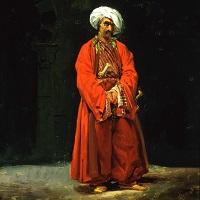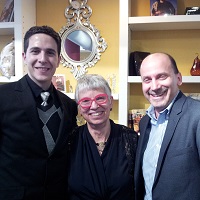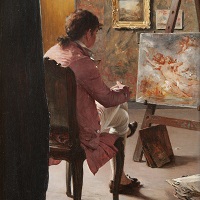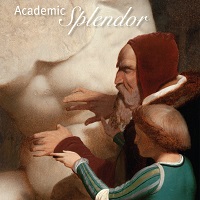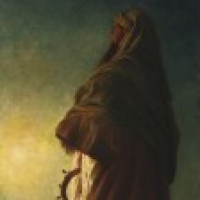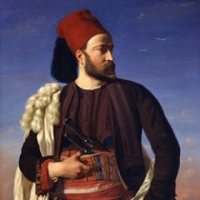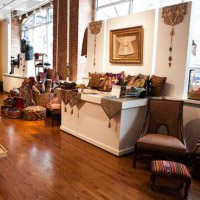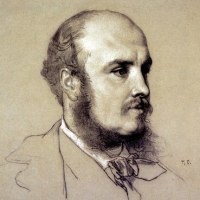- About
- Visit
- Exhibitions
- Collection
- Overview
- Search the Collection
- Recent Acquisitions
- SPOTLIGHT ON …
- Bouguereau’s “Amiable” Pictures Cross the Atlantic
- Back to Work
- The Allure of Animals in Academic Art
- Classical Mythology in 19th-century French Art
- Celebrities: Portrait medals in 19th-Century France
- Oriental “Native Types” from the Dahesh Collection
- Recording Islamic Architecture and Design
- French Natural Selections
- Painting Piety from the Dahesh Collection
- About Face: Learning to Draw Emotion through Expressive Heads
- From St. Petersburg to Paris: The Education of Russian Artists in France
- Picturing the News: The Birth of the Illustrated Press
- Egyptomania: 19th Century Depictions of Ancient Egypt
- The Franco-Prussian War and Its Aftermath in French Art
- Painting Pompeii: From Neoclassicism to the Néo-Grecs
- The Spanish Orient and Henri Regnault (French, 1843–1871)
- Women Artists Who Dared II: Jeanne Thil (French, 1887–1968) and Marie Hadad (Lebanese, 1889–1973)
- Women Artists Who Dared I: Rosa Bonheur (French, 1822–1899) and Elizabeth Gardner Bouguereau (American, 1837–1922)
- Peder Mork Mønsted’s (Danish, 1859–1941) Poetic Views of Nature
- Publications
- Programs
- Shop
- News
Category Archive for: ‘Art world News’
-
DAHESH MUSEUM OF ART ANNOUNCES FIVE NEW ACQUISITIONS
— World-Renowned Collection of 19th-Century Art Continues to Grow
Prior to Moving to New Museum Space —
New York, April 1, 2015 – The Dahesh Museum of Art today announced the acquisition of five new works that will significantly enhance its world-renowned collection of 19th-century art. The acquisitions, spanning 1851 to 1874, include three bronze statues, one oil on canvas painting, and one pencil and watercolor study heightened with gouache on card. The works are by artists Marius Jean Antonin Mercié (1845–1916), Aimé-Jules Dalou (1838–1902), Rosa Bonheur (1822–1899), and Sir Lawrence Alma-Tadema (1836–1912).Rosa Bonheur was the focus of an international retrospective created by the Dahesh Museum of Art in 1997; this is the seventh work by Bonheur to enter the Dahesh Museum collection. The watercolor study by Alma-Tadema is the preparatory work for a finished painting that is also within the Museum’s holdings. Alma-Tadema is among the most collectible Victorian artists (his painting The Finding of Moses sold at Sotheby’s in 2010 for $36 million). The three sculptures, by artists Mercié and Dalou, were a gift from Tracy and Laurel Pulvers.
“We are grateful to add these important works to our collection, and to eventually make them available to the public once we open at our new space at 178 East 64th Street,” said J. David Farmer, Director of Exhibitions for the Dahesh Museum of Art. “We have been actively acquiring new work for the past four years, and these works expand our growing insight into the 19th century and elaborate upon works we already possess.”
New Acquisitions
Marius Jean Antonin Mercié (French, 1845–1916)
David, ca. 1872
Bronze, brown patina, 25 1/2 x 12 3/4 x 17 7/8 in.
Signed on base, top right: A. MERCIÉ. Stamped on base at side back center: REDUCTION MECANIQUE A. COLLAS BREVETÉ.
Gift of Tracy and Laurel Pulvers
2014.4Mercié, one of the most successful sculptors of late 19th- and early 20th-century France, began as a pupil of François Jouffroy and Alexandre Falguière at the École des Beaux-Arts in Paris. He won the Prix de Rome in 1868 and found immediate success with the first plaster model of David that he executed while in Rome. This sculpture offered a glimmer of hope for France after its crushing defeat by Prussia in 1871. David, armed with a slingshot, brought down the giant Goliath, proving that France too could triumph over its enemy. The State awarded Mercié the Legion of Honor and in 1872 commissioned a bronze version of David (Musée d’Orsay). The Barbedienne foundry cast a miniature version in six different sizes.
Marius Jean Antonin Mercié (French, 1845–1916)
Gloria Victis (Glory of the Vanquished), modeled ca. 1874, cast after 1879
Bronze, dark brown patina with gilt highlights, 36 5/8 x 21 x 16 in.
Signed on base right: A. MERCIE. Inscribed on base at front edge: GLORIA VICTIS. Foundry mark on back base: F. BARBEDIENNE, Fondeur Paris. Stamped on back base: REDUCTION MECANIQUE A. COLLAS BREVETE.
Gift of Tracy and Laurel Pulvers
2014.3Mercié executed the plaster model for this group while studying in Italy as a Prix de Rome boursier and exhibited it at the 1874 Salon. The winged female figure carrying a wounded soldier holding a broken sword expresses the loss and sacrifice of the French at the hands of the Prussians in the 1870-71 war. The sculpture won critical and popular acclaim. In his review of the Salon that year, the critic Jules-Antoine Castagnary observed: “while monarchists quarrel over the debris of our battered fortunes…there exists a young sculptor who has undertaken to speak directly to our nation and to console our people who have suffered so much.” Mercié received a medal of honor, the city of Paris purchased the sculpture for 12,000 francs, and the model was cast in bronze by Thiébaut et fils (Musée du Petit Palais, Paris). Replicas of it adorned monuments dedicated to those who served in the Franco-Prussian War in many towns and cities throughout France, and the Barbedienne Foundry provided bronze reproductions in different sizes.
Aimé-Jules Dalou (French, 1838–1902)
The Woman of Boulogne
Bronze, green patina, 24 3/4 x 7 7/8 x 6 5/8 in.
Signed on base back top: Dalou. Foundry mark on base back bottom edge center: SUSSE Fres PARIS …rcue. Foundry mark on base bottom right: SUSSE FRÈRES EDITEURS PARIS. Inscribed on base bottom right: Susse Fes EJes Paris
Inscribed on base, bottom right: Susse Fes EJes Paris
Gift of Tracy and Laurel Pulvers
2014.5Best known for his public monuments in Paris, in 1870 Dalou began to create statuettes of women. During his exile in London from 1871 to 1879 following the fall of the Paris Commune, he executed a series of women from Boulogne—a theme made popular by the paintings of Alphonse Legros, who also lived in England at that time. The original composition, entitled Palm Sunday at Boulogne, was exhibited at the Royal Academy in 1872 and purchased by George Howard, later Earl of Carlisle. A girl returning from church clasps a prayer book and a branch of leaves, referencing the Palm Sunday mass. In London, Dalou frequently exhibited at the Royal Academy and taught at the National Art Training School in South Kensington (later the Royal College of Art), where he had a profound influence on the development of British sculpture
Rosa Bonheur (French, 1822–1899)
Going To Market, 1851
Oil on canvas, 19 x 27 1/4 in.
Signed and dated lower right: Rosa Bonheur 1851
2014.6When 29-year-old Bonheur painted Going to Market, her reputation as an animal painter was already firmly established. The composition, peasants with their ox-drawn carts, demonstrates Bonheur’s command of animal anatomy, which she had studied at horse fairs, cattle markets, and in the family menagerie. While Bonheur won the highest artistic and governmental honors in France, her works were also greatly admired in Great Britain and the United States.
Sir Lawrence Alma-Tadema (Dutch/British, 1836–1912)
Study for Joseph, Overseer of Pharaoh’s Granaries, ca. 1874
Pencil and watercolor heightened with gouache on card, 16 3/4 x 22 in.
2014.7This sheet by Alma-Tadema is related to the splendid painting in the Dahesh Museum collection, Joseph Overseer of Pharaoh’s Granaries (acquired in 2002), first exhibited in 1874 at the Royal Academy. The subject derives from the Book of Genesis, with Joseph seated on a throne in his role as the Pharaoh’s overseer of the royal granaries, accompanied by a scribe reading him the account of sales. The finished painting follows the general composition and colors of the sketch, with the addition of details of the ancient Egyptian decorations and accoutrements. This study was previously in the collection of Andy Warhol.
About the Dahesh Museum of Art
The Dahesh Museum of Art is the only institution in the United States devoted to collecting, exhibiting, and interpreting works by Europe and America’s academically trained artists of the 19th and early 20th centuries. The Dahesh serves a diverse audience by placing these artists in the broader context of 19th-century visual culture, and by offering a fresh appraisal of the role academies played in reinvigorating the classical ideals of beauty, humanism, and skill. Visit us at: http://www.daheshmuseum.org.
-
REORIENTATIONS EXHIBITION AT I.D.E.A. SPACE AT COLORADO COLLEGE FEATURES NINE MASTERWORKS FROM THE DAHESH MUSEUM OF ART COLLECTION
— Exhibition To Run From March 25 to May 7 —
New York, March 23, 2015 – The exhibition “ReOrientations: Defying and Defining 19th Century French Images of the Arab World” will appear at the I.D.E.A. Space of Colorado College from March 25 through May 7. The exhibition examines the ways in which Middle Eastern cultures have been portrayed historically, and how contemporary artists appropriate or disrupt these depictions. ReOrientations includes nine masterworks from the Dahesh Museum of Art collection, including artists Alphonse-Étienne Dinet (1861-1929), Eugène Alexis Girardet (1853-1907), Jean Raymond Hippolyte Lazerges (1817-1887), Émile-Jean-Horace Vernet (1789-1863), Alexandre-Marie Colin, (1798-1873), Eugène Fromentin (1820-1876), and Charles-Théodore Frère (1814-1888).
The exhibition catalog features essays by Colorado College faculty — Gale Murray, Claire Oberon Garcia, Ruth Kolarik, Robert Lee, Jane Murphy, and Michael O’Riely – which offer multiple perspectives on Orientalism and its legacies. The exhibition also includes works by contemporary artists Lalla Essaydi and Ibi Ibrahim.
“The collection of Orientalist works at the Dahesh Museum of Art continues to be a resource to world-class institutions working to understand this vital and important epoch of art,” said J. David Farmer, Director of Exhibitions at the Dahesh Museum of Art. “It is exciting to see how this tradition is interpreted for modern audiences in a contemporary idiom.”
The I.D.E.A. Space is located in the Edith Kinney Gaylord Cornerstone Arts Center, 825 N. Cascade Avenue, Colorado Springs, CO 80903, and is open Tuesday-through-Saturday, 12:30-7:00 PM.
About the Dahesh Museum of Art
The Dahesh Museum of Art is the only institution in the United States devoted to collecting, exhibiting, and interpreting works by Europe and America’s academically trained artists of the 19th and early 20th centuries. The Dahesh serves a diverse audience by placing these artists in the broader context of 19th-century visual culture, and by offering a fresh appraisal of the role academies played in reinvigorating the classical ideals of beauty, humanism, and skill. Visit us at: http://www.daheshmuseum.org.
# # #
-
ASIEL SEPÚLVEDA AWARDED BEST PAPER PRIZE AT TWELFTH ANNUAL GRADUATE STUDENT SYMPOSIUM IN NINETEENTH-CENTURY ART
— Event Co-Sponsored By The Dahesh Museum Of Art
And The Association Of Historians Of Nineteenth-Century Art —
New York, March 24, 2015 – Asiel Sepúlveda, a student at Southern Methodist University, won the Dahesh Museum of Art Prize for Best Paper at the 12th Annual Graduate Student Symposium in Nineteenth-Century Art, co-sponsored by the Dahesh Museum of Art and the Association of Historians of Nineteenth-Century Art (AHNCA), an organization designed to foster dialogue and communication among those who have a special interest in this field of nineteenth-century art and culture.
Sepúlveda’s paper, “Visualizing the Urban Environment: The Mulata and Tobacco Lithography in Mid-Nineteenth Century Havana,” examined how Havana’s mid-nineteenth century tobacco manufacturers employed printed ephemera and costumbrista types, such as the mulata, to portray African female sexuality as a disruptive force clashing with modernizing notions of cleanliness (both urban and racial), morality, and civil order in the midst of urban reformation. The winning entry will appear in an upcoming issue of Nineteenth Century Art Worldwide e-journal (http://www.19thc-artworldwide.org); the Best Paper prize is $1000, a gift from the Mervat Zahid Foundation.
“The papers presented at the symposium further demonstrate how young scholars continue to find new and innovative means of interpreting the nineteenth century,” said Alia Nour, Curator at the Dahesh Museum of Art. “We are indebted to these young people for continually revitalizing a field of study that attracts more and more scholars.”
The 2015 jury included Nebahat Avcıoğlu, Petra ten-Doesschate Chu, Marilyn Satin Kushner, Patricia Mainardi, and Peter Trippi; the symposium committee includee Caterina Pierre, Margaret Samu, and Mary Frances Zawadzki.
About the Dahesh Museum of Art
The Dahesh Museum of Art is the only institution in the United States devoted to collecting, exhibiting, and interpreting works by Europe and America’s academically trained artists of the 19th and early 20th centuries. The Dahesh serves a diverse audience by placing these artists in the broader context of 19th-century visual culture, and by offering a fresh appraisal of the role academies played in reinvigorating the classical ideals of beauty, humanism, and skill. Visit us at: http://www.daheshmuseum.org.
# # #
-
DAHESH MUSEUM OF ART CO-SPONSORS THE TWELFTH ANNUAL GRADUATE STUDENT SYMPOSIUM IN NINETEENTH-CENTURY ART
(Symposium Will Take Place Sunday, March 22, 2015, at the Dahesh Museum of Art Gift Shop).
New York, March 16, 2015 – The Graduate Student Symposium in Nineteenths-Century Art, co-sponsored by the Dahesh Museum of Art, will take place on Sunday, March 22, from 10:00 AM-to-5:00 PM at the Dahesh Museum of Art Gift Shop, 145 Sixth Avenue, on the corner of Dominick Street, one block south of Spring Street. The Museum will also present the Dahesh Museum of Art Prize for the Best Paper, a gift from the Mervat Zahid Cultural Foundation. The event is open to the public; reservations are recommended but not required.
“The nineteenth century continues to attract increased academic attention and world-class scholarship,” said J. David Farmer, Director of Exhibitions at the Dahesh Museum of Art. “Every year this symposium presents new and intriguing papers on diverse subjects within our realm of study and expertise. We are proud of the work these young scholars are producing and look forward to helping them lead the discussion on the importance of the nineteenth century.”
The Symposium is co-sponsored by the Association of Historians of Nineteenth-Century Art (AHNCA), an organization designed to foster dialogue and communication among those who have a special interest in this field of nineteenth-century art and culture. The 2015 jury consists of Nebahat Avcıoğlu, Petra ten-Doesschate Chu, Marilyn Satin Kushner, Patricia Mainardi, and Peter Trippi; the symposium committee includes Caterina Pierre, Margaret Samu, and Mary Frances Zawadzki.
SYMPOSIUM HIGHLIGHTS
10 AM: Welcome Presentation
Peter Trippi (President, Association of Historians of Nineteenth-Century Art)
10:15 AM – 11:15 AM: First Morning Session & Discussion
Patricia Mainardi (Program Chair, Association of Historians of Nineteenth-Century Art, & The Graduate Center, City University of New York), Moderator
Tamar Mayer, University of Chicago, “From Ancient to Modern Heroes: Transformations in Jacques-Louis David’s Preparatory Drawing Procedures”
In the early 1800s, Jacques-Louis David’s grand historical paintings no longer depicted classical themes but represented contemporary political events. In this paper, Tamar Mayer argues that this shift—from ancient to modern heroes—reflects decisive transformations in David’s preparatory drawing practices as well.
11:30 AM – 12:15 PM: Second Morning Session & Discussion
Peter Trippi (President, Association of Historians of Nineteenth-Century Art), Moderator
Sophie Lynford, Yale University, “Spiritualism in Landscape Painting and Photography: William Stillman’s Quest for Truth in Nature”
Considered the first American Pre-Raphaelite painter, William Stillman engaged multiple intellectual currents, including Ruskinian fidelity to nature, Transcendentalism, and Hudson River School aesthetics. In this paper, Sophie Lynford pays particularly close attention to Stillman’s participation in antebellum Spiritualism, arguing that his commitment to Spiritualist theory and practice found formal expression in his painting and, later, in his photography.
Alice J. Walkiewicz, The Graduate Center, City University of New York, “Transforming ‘The Song of the Shirt’: The Seamstress in Late Victorian Art”
Through the visual representation of working-class seamstresses, Alice Walkiewicz explores the relationship between labor reform and art production in late-19th-century Britain — a watershed moment in social history, when gender and labor issues were hotly debated as women increasingly sought employment outside the home, and industrialization changed the nature of work.
2:00 PM – 3:30 PM: First Afternoon Session & Discussion
Marilyn Satin Kushner (New-York Historical Society), Moderator
Emily Doucet, University of Toronto, “Anticipating Machines Heavier Than Air: Nadar, Photography and the Objects of Technology”
Emily Doucet examines a series of photographs taken by Nadar in 1863, featuring several model helicopters developed by Gustave Ponton d’Amécourt. Like the extensive technological description included in proto-science fiction literary texts of the same period, these images embody a mode of speculative fiction imagining a future in flight for machines heavier than air.
Nora Labo, University of St. Andrews, Scotland, “‘Can’t See the Forest for the Trees’: Jacques Huber’s Arboretum Amazonicum (1900-1906): The Difficulties of Representing Amazonian Complexity”
By examining a confusing and heterogeneous late-nineteenth-century portfolio of scientific nature photographs, Nora Labo will focus on the contradictions inherent in the colonial perceptions of Amazonia, and on the complex negotiations at work in the symbolic organization of a type of landscape which seemed to resist European ideas of order and rationality.
Giorgi Papashvili, Tbilisi State Academy of Arts, Georgia, “Gabashvili’s Art: Nationalism or Orientalism?”
The painter Giorgi Gabashvili (1862-1936) is known to the Western world as an Orientalist, but in Eastern Europe as the founder of Georgian Realist painting. Giorgi Papashvili will analyze his work in both Eastern and Western cultural contexts, including Orientalism, photography, ethnography, and nationalism.
3:45 PM – 4:45 PM: Second Afternoon Session & Discussion
(Nebahat Avcıoğlu, Hunter College, City University of New York), Moderator
Asiel Sepúlveda, Southern Methodist University, “Visualizing the Urban Environment: The Mulata and Tobacco Lithography in Mid-Nineteenth Century Havana”
Asiel Sepúlveda examines how Havana’s mid-nineteenth century tobacco manufacturers employed printed ephemera and costumbrista types, such as the mulata, to portray African female sexuality as a disruptive force clashing with modernizing notions of cleanliness (both urban and racial), morality, and civil order in the midst of urban reformation.
Maika Pollack, Princeton University, “‘Unconscious Nature’: Odilon Redon’s Portraits of La Femme Nouvelle, 1899-1910”
Redon’s pastels of women deploy non-local color as a new means of representing the femme nouvelle. Often Redon has been described as reactionary in the face of changing gender roles; Maika Pollack argues instead that these theosophically-inspired portraits depict female sitters with unprecedented subjectivity. Their luminous colors have implications for the development of painterly abstraction.
About the Dahesh Museum of Art
The Dahesh Museum of Art is the only institution in the United States devoted to collecting, exhibiting, and interpreting works by Europe and America’s academically trained artists of the 19th and early 20th centuries. The Dahesh serves a diverse audience by placing these artists in the broader context of 19th-century visual culture, and by offering a fresh appraisal of the role academies played in reinvigorating the classical ideals of beauty, humanism, and skill. Visit us at: http://www.daheshmuseum.org.
# # #
-
DAHESH MUSEUM OF ART PUBLISHES “ACADEMIC SPLENDOR: 101 MASTERPIECES FROM THE DAHESH MUSEUM OF ART COLLECTION”
New York, February 23, 2015 – The Dahesh Museum of Art has published a new book showcasing the masterworks within its holdings, Academic Splendor: 101 Masterpieces from the Dahesh Museum of Art Collection. The book sheds new light on the treasures of the European Academic Tradition, an area of art history that is increasingly important to the general public, collectors and scholars alike. The book is designed to foster a broader understanding of the Academy and its organized system of education, exhibitions and patronage, in addition to its role in the multifaceted 19th-century art world.
101 Masterpieces is available in both hardcover and softcover editions, with a choice of one-of-two covers. The informative and entertaining text is by DMA curator Alia Nour, with a Foreword by Dahesh Museum Trustee Amira Zahid, and an Introduction by Dahesh Museum Director of Exhibitions, J. David Farmer. It has 128 full-color illustrations, and presents works by more than 85 artists from both Europe and America.
Academic Splendor: 101 Masterpieces From the Dahesh Museum of Art succeeds the museum’s first handbook, Highlights from the Dahesh Museum Collection (1999), and presents the most current findings on a selection of its artists, in addition to accessible essays on the academic system and the history of the Dahesh Museum or Art. The book is organized according to the academic hierarchy of subjects, with sections devoted to history, historical genre, portraiture, landscape and animals, Orientalism, and still life paintings.
“The Dahesh has recently been adding to the collection with a renewed fervor, and new information on these artists and their work is continually coming to light,” said J. David Farmer, Director of Exhibitions at the Dahesh Museum of Art. “As the only museum devoted to the 19th- century Academic Tradition, it was essential that we update and upgrade our previous handbook. We are delighted with the finished product.”
Hardcover editions of Academic Splendor are $75, and softcover editions are only $60.
About the Dahesh Museum of Art
The Dahesh Museum of Art is the only institution in the United States devoted to collecting, exhibiting, and interpreting works by Europe and America’s academically trained artists of the 19th and early 20th centuries. The Dahesh serves a diverse audience by placing these artists in the broader context of 19th-century visual culture, and by offering a fresh appraisal of the role academies played in reinvigorating the classical ideals of beauty, humanism, and skill. Visit the museum at: http://www.daheshmuseum.org.
# # #
-
Dahesh Museum of Art Adds Newly Acquired Painting Into Exhibition at Museum of Biblical Art
Frederic Lord Leighton’s Star of Bethlehem has American Debut in Sacred Visions: Nineteenth-Century Biblical Art from the Dahesh Museum Collection
November 13, 2013, New York, New York — On Friday, November 8, 2013, Sotheby’s announced the top-ten sales results for its auction of 19th-Century European art. Included in that list was Frederic, Lord Leighton’s imposing Star of Bethlehem, purchased by the Dahesh Museum of Art, together with three other important paintings by other artists and complementing four artworks by Leighton already in the collection. The subject matter fits so perfectly within the scope of the current exhibition, Sacred Visions: Nineteenth-Century Biblical Art from the Dahesh Museum Collection, on view until February 16, 2014 at the Museum of Biblical Art, that curators and directors from each institution immediately agreed to add the painting to the current installation, an opportunity not to be missed.
“Yes, we know that this is not often done,” said Amira Zahid, founding trustee of the Dahesh Museum of Art and head of the acquisitions committee, “but who knows when we might have the chance to show this remarkable work within its proper context. So we seized the moment. Luckily, this large work is in great condition, has a lovely frame, and both our Museum and MOBIA are blessed with an enthusiastic, nimble staff of registrars, preparators, curators and exhibition designers. We worked together to make this change happen as quickly and seamlessly as possible.”
Richard P. Townsend, the Museum of Biblical Art’s director, commented “We are delighted to include this marvelous painting by one of the 19th century’s great artists in our exhibition. This reappraisal was made clear by the 1996 Royal Academy show and is quite apparent in this picture’s daring perspective and lush palette.”
According to Dahesh’s Associate Curator Alia Nour, “Our collaboration with MOBIA has been very productive from the start, so when I called Adrianne Rubin, my counterpart at MOBIA, we decided to remove two smaller paintings to make room for this very large one and started to work on a new label. We deemed it worthwhile to give visitors access to one of the most powerful biblical works Leighton produced during the 1860s.”
The Star of Bethlehem was last exhibited in 1996 in London at the Royal Academy of Arts’ major exhibition, Frederic Leighton 1830–1896. It was first shown there in 1862 and again in 1897, a year after his death. (Leighton was a member of the Royal Academy and its president from 1878 until his death in 1896.) Even then, no one was absolutely sure it depicted one of the three Magi, but there is no doubt the subject is a king (shown half-lifesize), who gazes at the Star’s mysterious, summoning light from the battlements of his palace. With crown in hand, as if leaving behind his worldly office, he stares into the distance–back to the spectator–involved in a journey of his own.
The Dahesh Museum of Art organized the exhibition Sacred Visions in conjunction with the Museum of Biblical Art. It opened on October 18, 2013, and will be on view until February 16, 2014. An introductory brochure and audioguide accompany the exhibition, along with adult, family, and community programs. The Dahesh Museum of Art has organized a scholarly symposium, in conjunction with MOBIA, to be held at MOBIA on January 17, 2014.
The Museum of Biblical Art, located at 61st Street and Broadway in New York City, is open six days a week: Tuesday – Sunday: 10am – 6pm, and offers programs on selected evenings. Admission is free. For details, visit mobia.org and daheshmuseum.org.
-
The New York Times on “Dahesh At Christie’s”
[via nytimes]
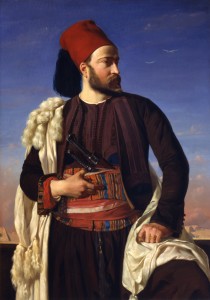 The Dahesh Museum of Art has been without a home since it vacated its premises at Madison Avenue and 57th Street in 2007. Since then it has been teaming with institutions like Syracuse University to keep its name and collection in the public eye.
The Dahesh Museum of Art has been without a home since it vacated its premises at Madison Avenue and 57th Street in 2007. Since then it has been teaming with institutions like Syracuse University to keep its name and collection in the public eye.Its latest partnership is sure to raise a few eyebrows, however. This week the institution said it had organized a show at Christie’s, “Encountering the Orient: Masterworks from the Dahesh Museum of Art,” which is to open on March 27. Is the Dahesh planning on selling some of its art?
“That will never happen,” said Amira Zahid, a member of the museum’s board. “We’re breaking new ground. This is an opportunity to show that art and commerce are not that far apart. We both believe in education and have something to offer the public together.”
Read More -
Hudson Square Tries to Encircle Residents
By Melanie Lefkowitz via The Wall Street Journal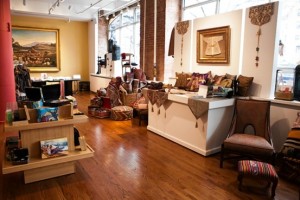 Deb’s Catering, a gourmet deli in Manhattan’s Hudson Square neighborhood, does a brisk business serving salads and sandwiches to office workers on weekday afternoons. But when those office workers go home for the day, Deb’s shuts down, too.
Deb’s Catering, a gourmet deli in Manhattan’s Hudson Square neighborhood, does a brisk business serving salads and sandwiches to office workers on weekday afternoons. But when those office workers go home for the day, Deb’s shuts down, too.“I’ve attempted to open on the weekends many times, but this neighborhood is pretty quiet on the weekends,” says Deborah Barall-Miller, owner of the 17-year-old shop.
That may be changing. A rezoning of Hudson Square that would pave the way for new residential development was approved last month by the City Planning Commission, and a City Council hearing on the matter is scheduled for Tuesday.
Meanwhile, a handful of new businesses and institutions, ranging from the Children’s Museum of the Arts on Charlton Street to a branch of Hale & Hearty Soups on Hudson, have opened within the past two years, drawing new visitors. And the area business improvement district, the Hudson Square Connection, formed in 2009, is working on an ambitious five-year plan to improve the neighborhood’s streets and sidewalks.
“What [local property owners] needed was to sort of knit this area into a neighborhood,” says Ellen Baer, president and chief executive of the Hudson Square Connection. “This whole area hasn’t had almost any infrastructure [work] done in almost 80 years.”< /p>
Hudson Square, sometimes called West SoHo, and roughly bounded by Canal and Houston streets, and Sixth Avenue and the Hudson River, is historically an industrial neighborhood, formerly home to many of the city’s printing presses. Today, its large Art Deco buildings have drawn creative and media companies, such as ad agency Saatchi & Saatchi, which was among the first to move into the area in 1985.
But although it borders some of the city’s priciest residential neighborhoods, Hudson Square has little housing or shopping and can feel deserted on nights and weekends.
“Because we don’t have a 24/7 population, it’s very difficult to get enough reta il here. We just got a drugstore but we don’t have a supermarket,” Ms. Baer says. “It’s unusual to have an area” within Manhattan that attracts so many workers “with so few residents,” she said. “I can’t even think of another one, frankly.”
The Hudson Square Connection’s $27 million street-improvement plan includes refurbishment of a small park at Spring Street and Sixth Avenue and creation of other small plazas, improvements to make Varick and Hudson streets more pedestrian- and bicycle-friendly and tree-planting throughout the neighborhood. The group would contribute $15 million toward the plan, with hopes that the city would finance the rest, Ms. Baer says.
Since the rezoning was proposed by Trinity Real Estate, which controls 40% of the property in Hudson Square, other developers have bought sites in the neighborhood. Some local advocates are concerned about what this could mean for the entire area.
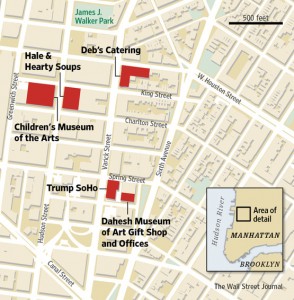 “If Hudson Square basically becomes the hot new neighborhood, which is what this rezoning is intended to make it…that is going to have a tremendous spillover effect on the South Village next door,” according to Andrew Berman, executive director of the Greenwich Village Society for Historic Preservation, who has pressed city officials to include a lower height limit, lower density and landmark protections for the South Village in any plans.
“If Hudson Square basically becomes the hot new neighborhood, which is what this rezoning is intended to make it…that is going to have a tremendous spillover effect on the South Village next door,” according to Andrew Berman, executive director of the Greenwich Village Society for Historic Preservation, who has pressed city officials to include a lower height limit, lower density and landmark protections for the South Village in any plans.With just a few residential buildings, the neighborhood already appeals to buyers seeking proximity to vibrant downtown areas, but with a quieter feel, brokers say.
“It’s really close to SoHo, which people love, but a lot of people don’t necessarily love living in the heart of SoHo,” says John Gomes, an executive vice president with Douglas Elliman. “It’s great to live in a quieter neighborhood where you can stroll to the water, or stroll east and be on Spring Street shopping at Prada.”
Yet the area can also be far from the subway and choked with traffic, particularly near the entrance to the Holland Tunnel at Canal Street.
Paula Webster, spokeswoman for the Dahesh Museum of Art, which recently opened a shop and office space at 145 Sixth Ave. after five years without a physical location, says the neighborhood feels like it is “on the verge.”
“We have a long view, and we feel like we want to grow with the neighborhood,” Ms. Webster says. “The neighborhood is very exciting, because there is this feeling of expansion and transformation, and we’re in a mode of transformation ourselves.”
-
New York Times reviews “The Essential Line”
Before the advent of action movies, thrill-seekers could always check out some history paintings for the kind of visceral excitement now provided by the likes of James Bond and Jason Bourne. And anyone who has doubts about the similarities between the old and new kinds of blockbuster needs only to have a look at “The Essential Line: Drawings From the Dahesh Museum of Art,” a small, punchy exhibition at Fairfield University’s Bellarmine Museum.
-
Dahesh Museum Gift Shop in TimeOut New York
TimeOut says
 The institution devoted to 19th- and 20th-century European art has moved downtown, along with its chic gift shop. The eclectic space allows you to take a piece of art home via Charles Bargue lithograph prints ($180); books such as Nigel Spivey’s Greek Art ($30), which describes the extensive history of Grecian artistry; and intricately designed Syrian tables ($325–$550). The versatile store also sells handcrafted Parisian pillboxes ($48), multicolored recycled-glass bracelets ($20) and putti silk scarves ($65).
The institution devoted to 19th- and 20th-century European art has moved downtown, along with its chic gift shop. The eclectic space allows you to take a piece of art home via Charles Bargue lithograph prints ($180); books such as Nigel Spivey’s Greek Art ($30), which describes the extensive history of Grecian artistry; and intricately designed Syrian tables ($325–$550). The versatile store also sells handcrafted Parisian pillboxes ($48), multicolored recycled-glass bracelets ($20) and putti silk scarves ($65).



